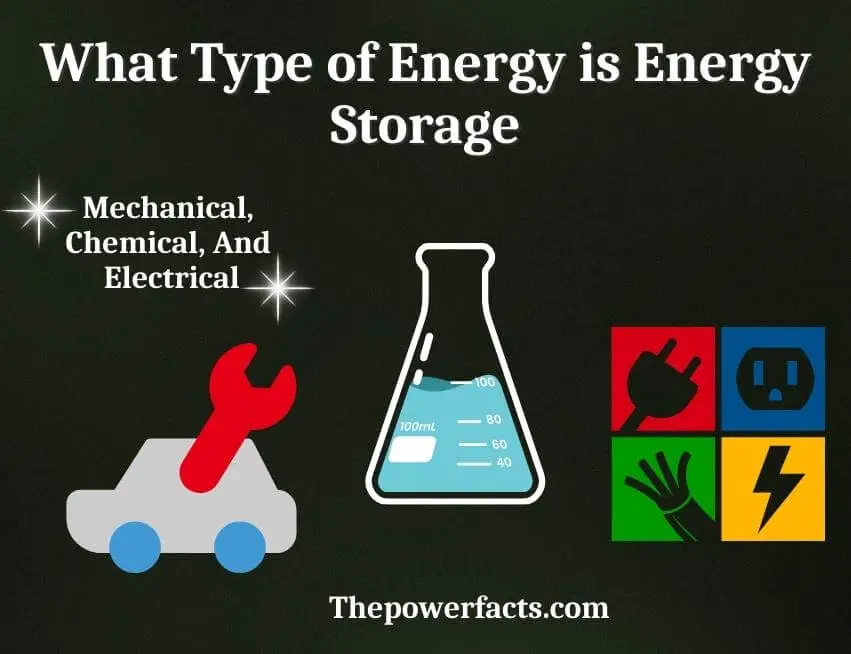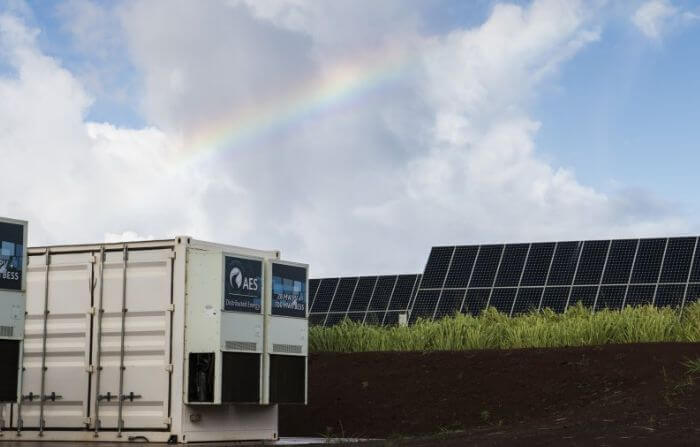Energy is the ability to do work. It comes in many forms and can be converted from one form of energy to another. The three primary forms of energy are: mechanical, chemical, and electrical.
Energy storage is the capture of energy that would otherwise be lost or wasted and its conversion into a more useful form for later use. There are many different types of energy storage, but they can generally be classified into four main categories: potential, kinetic, thermal, and electrical.

There are many forms of energy storage, but the most common form is electrical energy storage. This type of storage is used to store energy in batteries or other electrochemical devices. The stored energy can be converted back into electricity when needed.
Other forms of energy storage include mechanical energy storage, such as in flywheels, and chemical energy storage, such as in hydrogen fuel cells.
Types of Battery Energy Storage Systems
There are several types of battery energy storage systems (BESS) available on the market today. Here is a brief overview of the most common types:
1. Lead-acid batteries have been around for over 150 years and are the most economical option.
They are, however, heavy and require regular maintenance.
2. Lithium-ion batteries are the newest technology and offer the highest energy density (the amount of energy stored in a given volume). They are, however, more expensive than lead-acid batteries and can be sensitive to temperature extremes.
3. Sodium-sulfur batteries use molten sodium and sulfur as their electrolyte, which allows for a very high energy density. However, they require extremely high operating temperatures (>300°C / 572°F), making them impractical for many applications.
4. Nickel-cadmium batteries were once popular but have fallen out of favor due to their toxicity ( cadmium is a known carcinogen).
Nickel-metal hydride batteries are now used in most consumer electronics instead.
5. Flow batteries store their electrolyte in external tanks, which makes them scalable to very large capacities without increasing their footprint too much. The downside is that they tend to be quite expensive compared to other BESS technologies.
Energy Storage Technologies Comparison
There are many different types of energy storage technologies, each with its own advantages and disadvantages. Here is a comparison of some of the most common types of energy storage technologies:
1. Batteries
Batteries are perhaps the most well-known type of energy storage technology.
They can be used to store both renewable and non-renewable forms of energy, making them very versatile. However, batteries tend to be expensive, and their capacity tends to decrease over time.
2. Flywheels
Flywheels store energy in the form of kinetic energy and can be made from either metal or composite materials.
Flywheels are very efficient at storing and releasing energy, but they require careful maintenance and can be dangerous if not handled properly.
3. Hydrogen Storage
Hydrogen can be stored in either gaseous or liquid form, making it a very versatile fuel source. Hydrogen is also relatively clean-burning, making it an environmentally-friendly option.
However, hydrogen is extremely flammable, so proper safety precautions must be taken when storing or using it.
4. Compressed Air Storage
Compressed air can be stored in tanks at high pressures, making it a very dense form of energy storage. Compressed air is often used as an alternative to batteries in some applications due to its similar discharge characteristics.
Electrical Energy Storage
As the renewable energy industry continues to grow, so does the need for efficient storage methods of electrical energy. Electrical energy storage is a key piece of technology in making sure that renewable energy sources can be utilized to their fullest potential. Here we will discuss some of the different types of electrical energy storage systems and their advantages and disadvantages.
One type of electrical energy storage system is called pumped hydroelectricity. In this system, water is pumped from a lower-elevation reservoir to a higher-elevation reservoir when there is excess electricity available. When there is a demand for electricity, the water is released back down through turbines, generating electricity.
Pumped hydroelectricity systems are very large-scale and expensive to build, but they are also very efficient, with up to 80% efficiency. Another type of electrical energy storage system uses batteries. Batteries come in many different sizes and chemistries, making them suitable for a wide range of applications.
The main advantage of batteries over other methods is that they can store large amounts of electricity without taking up much space. However, batteries are typically only around 50-60% efficient, meaning that a lot of the stored electricity is lost when it is converted back into a usable form. Additionally, batteries have a limited lifetime and must be regularly replaced or recharged, which can add significant costs over time.
A third method of storing electrical energy is called flywheels. Flywheels store kinetic energy in the form of spinning disks or wheels that can reach speeds up to 20,000 rpm. When there is excess electricity available, flywheels are spun faster; when there is demand for electricity, the flywheels are used to drive generators and produce power.
Flywheels are very efficient (up to 95%), but they require special containment vessels that can be expensive to build. Additionally, flywheels can only store enough energy for a short period of time, so they would need to be supplemented with other forms of storage for longer-term needs.
How to Store Energy in Battery?
Batteries are one of the most important components of any electronic device. They provide the power needed to operate the device, and they need to be able to store that power for when it is needed. There are many different types of batteries, and each has its own advantages and disadvantages.
The type of battery you use will depend on the application for which you need it. The three most common types of batteries are lead-acid, nickel-cadmium, and lithium-ion. Lead acid batteries are the oldest type of battery, and they are still used in some applications today.
They are very rugged and can withstand a lot of abuse, but they are also very heavy. Nickel-cadmium batteries were once the most popular type of battery, but they have been replaced by lithium-ion batteries in most applications due to their higher energy density. Lithium-ion batteries are now the most popular type of battery due to their high energy density and low weight.
When choosing a battery for your application, you need to consider both the discharge rate and the capacity. The discharge rate is how fast the battery can deliver its stored energy, and it is usually expressed in amps or watts. The capacity is how much energy the battery can store, and it is usually expressed in amp-hours or watt-hours.
You need to choose a battery with a high enough discharge rate for your application and a high enough capacity to meet your needs. Once you have chosen the right battery for your application, you need to know how to store it properly so that it will last as long as possible. Batteries should be stored in a cool, dry place out of direct sunlight.
If possible, they should be stored at room temperature or below; extreme heat can shorten their lifespan significantly. Batteries should also be stored away from metal objects such as tools or keys; these can short-circuit the terminals and cause damage to the cells inside.
Chemical Energy Storage
Chemical energy storage is the process of storing energy in the form of chemical bonds. This type of storage is one of the most efficient ways to store energy, as it can be converted back into usable energy with very little loss. Chemical energy storage can be used to store both renewable and non-renewable forms of energy, making it a versatile option for many different applications.
| One common type of chemical energy storage is in the form of batteries | Batteries work by converting chemical energy into electrical energy, which can then be used to power electronic devices. There are many different types of batteries, each with its own advantages and disadvantages. |
| Another type of chemical energy storage is in the form of fuel cells | Fuel cells convert chemical energy into electrical energy through a reaction between hydrogen and oxygen. Fuel cells are often used in applications where high levels of power are required, such as in electric vehicles or backup power generators. |
| Chemical energy storage is a critical part of our modern infrastructure | Providing a way to store large amounts of energy for later use. As we move towards a more sustainable future, it will become even more important to develop efficient methods of storing renewable forms of energy. |
Mechanical Energy Storage
There are many different ways to store energy, but one of the most efficient is mechanical energy storage. This type of storage can be used to store both potential and kinetic energy, making it ideal for a wide range of applications.
One of the most common ways to store mechanical energy is through the use of springs.
By compressing or stretching a spring, you can store large amounts of energy that can be released later on. This is how many wind-up toys work, and it’s also how some car engines are able to start quickly without using a lot of battery power.
Another popular method of mechanical energy storage is flywheels.
A flywheel is simply a large wheel that’s attached to an axle and free to rotate. When you spin the flywheel, it stores kinetic energy in its rotation. This stored energy can then be used later on to help power machinery or keep processes going smoothly.

What is an Example of Storing Energy?
An example of storing energy is using a battery. A battery stores energy in the form of electric potential energy. The chemical reaction inside the battery creates an electric field, which stores the potential energy.
How does the Renewable Fuel Standard impact energy storage in batteries?
The benefits of renewable fuel standard have a direct impact on energy storage in batteries. By promoting the use of renewable fuels, the standard encourages the development of advanced energy storage technologies, such as batteries, to support the integration of renewable energy sources into the grid. This helps to improve grid reliability and reduce reliance on fossil fuels.
What Type of Energy Storage is a Battery?
A battery is a device that stores energy in the form of electrical charge. There are many different types of batteries, but all work by storing charges on electrodes and then releasing them when an electric current is passed through the battery. The most common type of battery is the lead-acid battery, which is used in cars and other vehicles.
Final Verdict
There are many different types of energy storage, each with its own advantages and disadvantages. The most common type of energy storage is chemical storage, which can be either in the form of a battery or a fuel cell. Other types of energy storage include mechanical storage (such as in a flywheel), thermal storage (such as in a heat sink), electrical storage (such as in a capacitor), and gravitational potential energy storage (such as in a dam).